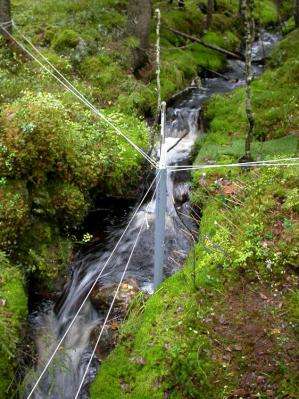A riparian zone along a headwater stream in the Krycklan catchment area with instruments measuring water levels (logger in the PVC tube), simulated plant damage (wooded sticks), and simulated sedimentation (PVC carpets). Credit: Lenka Kuglerová
The patterns of plant species diversity along Swedish boreal streams are closely linked to flow of surface and sub-surface water. The linkages between vegetation and hydrology are tight, and according to Lenka Kuglerová they are threatened by poorly designed forest management. She defends her thesis at Umeå University on Thursday 26 March.
Riparian zones – the areas around rivers and streams which are temporarily flooded – are important components of the boreal landscape. They are species rich and important for stream water quality and quantity, and aquatic food webs.
"I found strong relationships between plant species richness and position in the catchment. The position in the catchment is important because it determines how much water flows into the particular location", says ecologist Lenka Kuglerová.
Lenka Kuglerová studied riparian vascular plants, mosses and liverworts along a gradient of stream sizes in northern Sweden: from small headwaters in the Krycklan catchment area to the large Vindel River. The results show that species richness of riparian vegetation increases with increasing stream size.
"This is a result of increasing flood disturbance and inundation with increasing stream size, which enhances the heterogeneity of riparian habitat conditions, improves soil fertility, and increases water-dispersal success. This makes riparian zones along larger rivers favourable to more plant species", says Lenka Kuglerová.
Vegetation was also largely affected by groundwater in riparian zones. In areas where groundwater – travelling from surrounding uplands – discharges, more vascular plant species were found. Those riparian sites were also wider and had species rich communities of vascular plants, mosses, and liverworts further away from the stream channels in comparison to adjacent areas without groundwater discharge.
Groundwater discharge in riparian zones is beneficial not only for plant species richness but also for water chemistry and in turn for fish and aquatic insects. Groundwater discharge provides the environment with stable temperature and chemistry with higher pH and nitrogen availability.
Lenka Kuglerová suggests that Swedish forestry should stop using uniform widths of so called riparian buffers (vegetated strips along streams and rivers spared from logging) during forest harvest.
"Instead, hydrologically determined buffer widths should be applied with wider riparian buffers in groundwater discharge areas and narrower in riparian zones without groundwater. By this, we can protect biochemical and ecological hotspots, and avoid forestry machines getting stuck damaging the wet riparian soils."
Lenka Kuglerová has also studied the effects of stream restoration on riparian plants. Many streams in Sweden have been channelised in the past, to facilitate timber floating. Currently, streams are being restored to resemble natural, pre-channelisation conditions. The results of Lenka Kuglerová's research indicate that restoring streams has the potential to increase species richness and biomass of riparian plants due to improvement of riparian habitat.
"The time for this recovery is however long and thus, the results are not as fast as we would wish for. Riparian environment became more favourable for plant growth after restoration but vegetation needs more time to recover and reach stable conditions", says Lenka Kuglerová.
More information: The thesis is available online: umu.diva-portal.org/smash/get/ … 90801/FULLTEXT01.pdf
Provided by Umea University





















